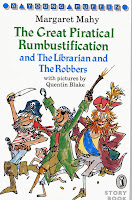In respectful memory of the magnificent Margaret Mahy 1936-2011
By Prue Goodwin
I have a
whole collection of books – picturebooks, novels, poetry and short stories - that
have literacy (both reading and writing) as pivotal elements of their plots. I read
extracts from them to illustrate my lectures on literacy learning. For example,
when talking about writing I read the first few pages of Love that dog by Sharon Creech; Ink-Slinger,
an anthology compiled by Morag Styles and Helen Cook, provides a wealth of
poetry; and Frindle, by Andrew
Clements, is perfect for discussing vocabulary. But there is one book that goes
with me to every presentation I give, no matter what the focus of my talk. Its
title? The Great Piratical
Rumbustification and The Librarian
and the Robbers by Margaret Mahy. In addition to these stories both being
hilarious, the illustrations are by the king of illustrators, Sir Quentin
Blake.
My favourite story
for sharing with colleagues is The
Librarian and the Robbers. The story tells of the experiences of a local
librarian, Miss Selena Laburnum, and especially of the gradual development of her
relationship with a band of wicked robbers. Following her kidnap, Miss Laburnum
finds herself nursing the robbers through the ‘raging measles’. Only access to
the library can ensure their recovery. While the Dictionary of Efficient and Efficacious Home Nursing enables Serena
to tend to the poorly thieves’ medical needs, she soothes their fevered brows
reading children’s books aloud to them. Later
in the tale, the eventual transformation of ‘almost illiterate’ robbers into
avid readers leads to the council opening a children’s library.
Never in all their
lives had those robbers been read to. In spite of the fever induced by raging
measles they listened intently and asked for more.
‘Tell us more about that B’rer Rabbit!’ was the fretful cry of the infectious villains. ‘Read to us about Alice in Wonderland.’
‘Tell us more about that B’rer Rabbit!’ was the fretful cry of the infectious villains. ‘Read to us about Alice in Wonderland.’
What makes
this book so invaluable?
Well, to
start with, it celebrates the power of listening to good books being read
aloud. According to Mahy, listening to literature is not only ‘efficient and
efficacious’ enough to help cure measles but it also gives listeners of any age
a hunger for more books; in particular, for more stories. Following the measles
episode, the tale continues with the robber chief bursting into the library
(whilst being pursued by a policeman) in order to obtain more books for his
gang. Miss Laburnum ‘hides’ the Robber Chief (whose surname is Loveday) on
shelf beside authors with surnames beginning with ‘L’ (‘Alphabetical order is a
habit with librarians.’).
‘Miss Laburnum,’ said
the policeman, ‘I have just had occasion to pursue a notable Robber Chief into
your library. I can see him there in the bookshelves among the L’s. May I take
him out please?’
‘Certainly!’ said Miss Laburnum pleasantly. ‘Do you have your library membership card?’
‘Certainly!’ said Miss Laburnum pleasantly. ‘Do you have your library membership card?’
Everything
about this short story relates to books, reading and libraries from her kidnap at
the beginning of the book through to the delightful conclusion involving her burgeoning
relationship with the Robber Chief; (‘Oh, Miss Laburnum, will you marry me?’). It
is beautifully written, witty and engaging from beginning to end. It also contains
one of my all-time favourite quotes: As a result of an earthquake, Selena is
trapped beneath a bookshelf and its contents of ancient books. ‘Pulverised by
literature,’ thought Miss Laburnum. ‘The ideal way for a librarian to die.’
The
magnificent Margaret Mahy presents reading as an exciting undertaking. In short, her version of literacy is an
irresistible invitation to take part in a range of unexpected and slightly
anarchic adventures – reading to robbers, dancing with pirates, playing with poetry
and generally subverting the frequently stuffy worlds of adulthood and
education. Whilst her stories confirm that reading can provide future security and
happiness, she also convinces us that books, libraries and being a reader are all
packed with the thrill of revolution. If you aspire to a life full of unexpected
exploits and all things delightful, become a reader! Treasure awaits us all on
the shelves of the library.


